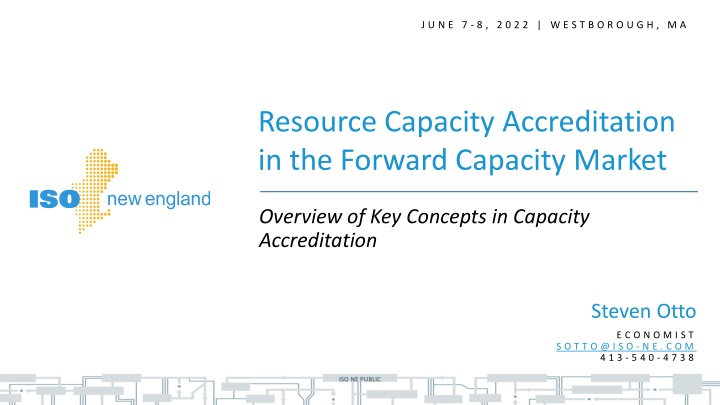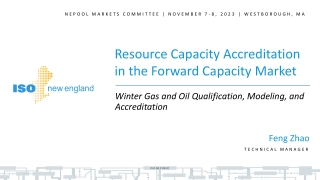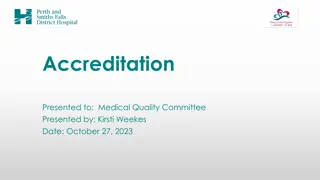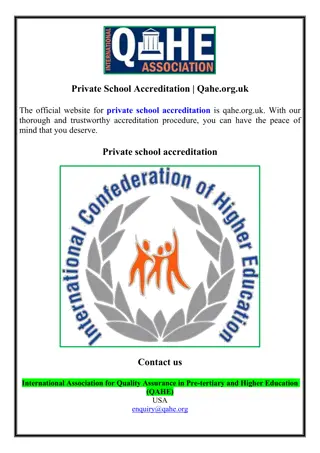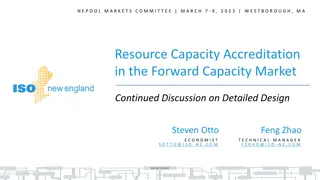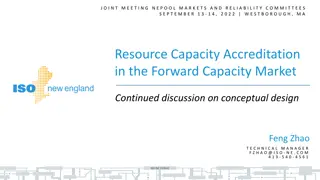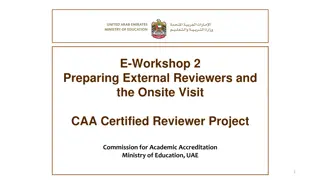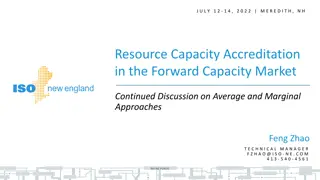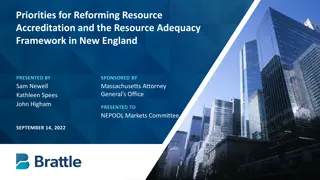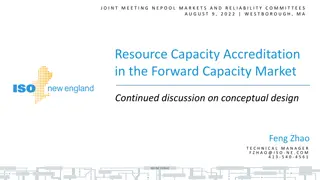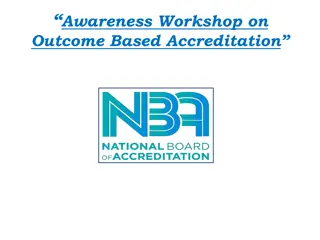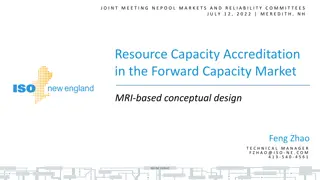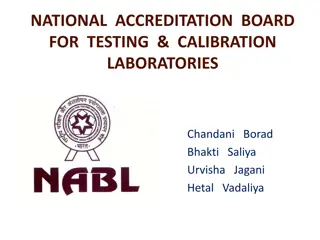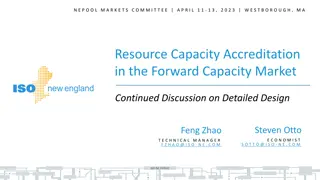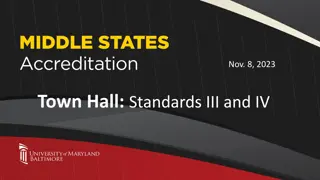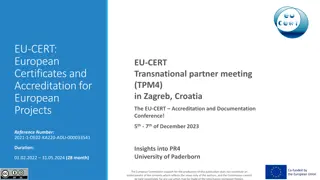Resource Capacity Accreditation in Forward Capacity Market Overview
Resource Capacity Accreditation project aims to enhance ISO-NE's accreditation processes in the Forward Capacity Market, supporting a reliable, clean-energy transition. Key concepts covered in this educational presentation include accreditation space, methods, benefits, challenges, and improvement opportunities. Technical sessions have explored different approaches like Heuristic, ELCC, and MRI for capacity accreditation.
Download Presentation

Please find below an Image/Link to download the presentation.
The content on the website is provided AS IS for your information and personal use only. It may not be sold, licensed, or shared on other websites without obtaining consent from the author.If you encounter any issues during the download, it is possible that the publisher has removed the file from their server.
You are allowed to download the files provided on this website for personal or commercial use, subject to the condition that they are used lawfully. All files are the property of their respective owners.
The content on the website is provided AS IS for your information and personal use only. It may not be sold, licensed, or shared on other websites without obtaining consent from the author.
E N D
Presentation Transcript
J U N E 7 - 8 , 2 0 2 2 | W E S T B O R O U G H , M A Resource Capacity Accreditation in the Forward Capacity Market Overview of Key Concepts in Capacity Accreditation Steven Otto E C O N O M I S T S O T T O @ I S O - N E . C O M 4 1 3 - 5 4 0 - 4 7 3 8 ISO NE PUBLIC
WMPP ID: 157 Resource Capacity Accreditation in the Forward Capacity Market Proposed Effective Date: FCA 19 The Resource Capacity Accreditation (RCA) project proposes improvements to ISO-NE s accreditation processes in the Forward Capacity Market (FCM) to further support a reliable, clean-energy transition by implementing methodologies that will more appropriately accredit resource contributions to resource adequacy as the resource mix transforms The ISO has made a commitment to FERC to file proposed improvements in time for FCA 19 This presentation provides an educational foundation for future discussion on capacity accreditation To this end, it covers key concepts in the accreditation space, but does not cover any conceptual design components or proposals Numerical examples included do not reflect estimates of the impacts of potential reforms but are merely stylized examples ISO NE PUBLIC 2
WMPP ID: 157 Resource Capacity Accreditation in the Forward Capacity Market Proposed Effective Date: FCA 19 Today s discussion will focus on: Conceptual overview of purpose of capacity accreditation (slides 5-9) Discuss different accreditation methods (slides 10-14) Discuss average and marginal approaches to accreditation at a conceptual level (slides 15-23) Define a common nomenclature for discussions (slides 24-25) Discuss benefits and challenges of average and marginal approaches (slides 26-27) Introduce FCM design objectives and opportunities for improvement (slides 28-32) Overview of stakeholder schedule (slides 36-40) ISO NE PUBLIC 3
Prior Outreach and Background: Technical Sessions On August 20, 2021, the ISO presented technical background and general concepts behind different resource capacity accreditation methodologies A subsequent technical session was held on November 22, 2021, where stakeholders presented their experiences and insights on capacity accreditation in other RTOs These technical sessions covered foundational concepts in capacity accreditation, including: Heuristic, ELCC, and MRI approaches to accreditation Differences between average and marginal approaches to accreditation ISO NE PUBLIC 4
REVIEW OF KEY CONCEPTS IN CAPACITY ACCREDITATION ISO NE PUBLIC ISO-NE PUBLIC 5
Resource Adequacy Assessment Generally speaking, a resource adequacy assessment process consists of: Quantifying the contributions of resources (i.e., capacity) to meet, A specific target for a reliability metric ( loss of load ), for a specific (future) time period or planning horizon, using A specified quantitative methodology In practice, this requires the use of simulation models and considerable data on many inputs Today s discussion will focus on the first piece of this process: quantifying the contributions of resources to resource adequacy ISO NE PUBLIC 6
Capacity Accreditation Capacity accreditation processes quantify resources reliability contributions to resource adequacy Accreditation processes use each resource s physical characteristics (e.g., their nameplate capability, technology, location, etc.) to determine an accreditation value, which is the maximum amount of capacity that the owner can sell in a forward reliability market Because of differences in contributions to resource adequacy, some resources will need more MWs of nameplate capacity than others to have a similar quantity of accredited capacity E.g., an intermittent resource with 100 MW of nameplate capacity may have 20 MW of accredited capacity while a 25 MW thermal resource may have the same 20 MW of accredited capacity ISO NE PUBLIC 7
Purpose of Capacity Accreditation Capacity accreditation allows resources with disparate features that may have different reliability contributions toward resource adequacy per nameplate MW (e.g., solar vs. nuclear resources) to sell the same uniform product: accredited capacity The accreditation process should yield accredited capacity that is substitutable across resources Substitutability implies that small changes in the accredited capacity of different resources have approximately the same impact on resource adequacy ISO NE PUBLIC 8
Substitutability When comparing resources to determine who should clear the next increment of accredited capacity, substitutability allows for the direct comparison of different resources costs ($/kW-month), even when the resources have significantly different attributes/characteristics If accredited capacity is not substitutable, costs cannot be easily compared to determine which resources should be procured to best meet resource adequacy requirements at lowest cost because the resources will provide different contributions per unit of accredited capacity The ability to directly compare costs allows a more optimal resource mix to be achieved ISO NE PUBLIC 9
APPROACHES TO ACCREDITATION ISO NE PUBLIC ISO-NE PUBLIC 10
Different Methodologies to Accredit Capacity Heuristics. Heuristic approaches employ practical rules to determine accredited capacity Some of the current accreditation methods in New England are based on heuristics E.g., the accredited capacity of an intermittent resource is based on historical average output in a predetermined set of hours Installed Capacity (ICAP). Represents physical generating capacity adjusted for ambient weather conditions Unforced Capacity (UCAP). Similar to the ICAP approach, but also incorporates resources expected forced outage rates (EFORd) E.g., a resource with 100 MW of installed capacity and an EFORd of 10% would have a UCAP value = 90 MW ISO NE PUBLIC 11
Different Methodologies to Accredit Capacity, cont. Effective Load Carrying Capability (ELCC). A resource s ELCC value measures the equivalent amount of additional load the system could serve ( carry ) with the resource (versus without it), while meeting the same target number of load shed events Alternatively, ELCC is often measured as the amount of perfect capacity needed to serve load without the (entire) resource under evaluation while meeting the same target number of load shed events Marginal Reliability Impact (MRI). A resource s MRI value measures the incremental impact of its last MW on system reliability Similar to the MRI concept that underpins the capacity demand curves Note there are numerical examples that demonstrate ELCC and MRI approaches in Appendix B. Appendix A also includes additional reference material that considers ELCC and MRI approaches in greater detail ISO NE PUBLIC 12
ISO-NEs Current Approach to Accreditation No two ISOs/RTOs have identical accreditation processes ISO-NE currently uses a mix of an installed capacity (ICAP) approach and heuristics to generate resources accreditation values, which we call their qualified capacity (QC) values Non-intermittent generation resources are accredited based on the resource s average output over a defined audit duration (median of the yearly average over five years) Intermittent generation resources are accredited based on their median output during predetermined reliability hours (average over five years) Import capacity resources are accredited based on documentation that demonstrates the capability and commitment of the resources backing the Imports Active demand resources are accredited in a similar manner to non-intermittent generation resources Passive demand response resources are accredited based on documentation supporting requested demand reduction values and consider the amount of capacity cleared and permanently removed in previous FCAs and expiring measures for EE resources ISO NE PUBLIC 13
Accreditation Approaches in Other Regions NYISO is transitioning to a marginal method they refer to as Marginal Reliability Improvement PJM utilizes a UCAP construct for conventional resources and an average ELCC for energy limited or intermittent resources MISO utilizes a UCAP construct for most resource types and an average ELCC approach for wind resources More details on the accreditation approaches in the other regions can be found in Appendix A and were discussed during the November, 2021 technical session ISO NE PUBLIC 14
CONCEPTUAL DISCUSSION OF AVERAGE VS. MARGINAL APPROACHES ISO NE PUBLIC ISO-NE PUBLIC 15
Average vs. Marginal Approaches Speaking broadly, ELCC approaches can be described as either marginal or average, while the MRI approach is a marginal approach At a high level, marginal approaches set a resource s accredited capacity based on the marginal reliability impact of an incremental change in its size Average approaches set a resource s accredited capacity based on the average reliability impact of each resource s respective class These approaches and their differences have been discussed in PJM, NYISO, and with FERC in recent stakeholder and regulatory proceedings (see Appendix A material) The next few slides include graphical demonstrations of marginal and average approaches to accreditation, including how the two approaches generally determine capacity accreditation, and how (and under what circumstances) these approaches can produce different outcomes ISO NE PUBLIC 16
Loss of Load Expectation and Expected Unserved Energy Expected Unserved Energy (EUE) is a reliability metric that measures the total amount of load shed expected in a given year, measured in MWh/year Loss of Load Expectation (LOLE) is a reliability metric that measures the number of load shed events that the region expects to observe in a given year, measured in days/year NPCC uses the LOLE concept in their one-day-in-ten standard and the ISO uses LOLE to calculate it s Installed Capacity Requirement (ICR) The ISO uses the EUE concept in developing its demand curves for use in the Forward Capacity Market because it accounts for the severity of load shed events For example, the LOLE concept does not distinguish between a day with 10 MWh of load shed and a day with 500 MWh of load shed. This distinction is captured by the EUE concept In concept, both average and marginal approaches could be applied with respect to EUE or LOLE. For today, we will use EUE as it is the ISO s market metric used to calculate capacity demand curves ISO NE PUBLIC 17
Graphical Demonstration of Marginal Approach This figure shows the marginal reliability contribution of a resource class at different penetrations of that class 10 Contribution (hours/year) Marginal Reliability Illustrates EUE as the relevant reliability measure, where the marginal reliability contribution is the MWh decrease in EUE given a 1 MW increase in the class penetration The units for marginal reliability contribution is MWh/MW/year, or hours/year, as with the capacity demand curves 7 4 1,000 500 Capacity (MW) Continued on the next slide ISO NE PUBLIC 18
Graphical Demonstration of Marginal Approach, cont. Suppose there are 999 MWs of the resource class in the mix and the region is considering the addition of a 1 MW resource in the class, represented by the blue dot 10 Contribution (hours/year) Marginal Reliability 7 4 1,000 500 Capacity (MW) Continued on the next slide ISO NE PUBLIC 19
Graphical Demonstration of Marginal Approach, cont. The marginal reliability contribution of the potential new resource is the height of the marginal reliability contribution line at the class penetration, assuming the new resource is built Conceptually, marginal approaches accredit all resources using this marginal reliability contribution E.g., the resource represented by the blue dot would be accredited based on the 4 hours/year value ISO NE PUBLIC 20
Graphical Demonstration of Average Approach The shaded area under the marginal reliability contribution curve up to and including the blue dot represents the total reliability contribution of the class, assuming the new resource is built This area is measured in MWh of decreased EUE, and equals 7,000 MWh 10 Contribution (hours/year) Marginal Reliability 7 4 1,000 500 Capacity (MW) Continued on the next slide ISO NE PUBLIC 21
Graphical Demonstration of Average Approach Conceptually, average approaches accredit resources using their share of their class total contribution to reliability E.g., under an average approach, the 1 MW blue dot resource would be accredited based on their share (1 MW/1,000 MW) of the class total reliability contribution, in this case 7 hours/year Continued on the next slide ISO NE PUBLIC 22
Average vs. Marginal Takeaways Marginal approaches accredit all resources based on their marginal contribution to reliability Average approaches accredit resources based on their share of their class total contribution to system reliability Marginal approaches generally lead to accreditation values that are less than or equal to average approach s accreditation values because many resources have declining contributions to reliability as their class penetration increases Note if the marginal reliability contribution of a class is constant (e.g. the marginal reliability contribution line is horizontal), the average and marginal approaches should yield the same accreditation value ISO NE PUBLIC 23
Nomenclature When discussing these concepts and approaches going forward, a commonly understood nomenclature is helpful: Accredited capacity measures a resource s estimated reliability contribution and is used to determine the maximum amount of capacity a resource can sell in a forward reliability/capacity market Qualified capacity ISO-NE s current approach to accrediting resources using a combination of ICAP and heuristic approaches Substitutability resources are substitutable if changes in the accredited capacity of different resources have approximately the same impact on resource adequacy Marginal approach accredits resources based on their marginal contribution to reliability Continued on the next slide ISO NE PUBLIC 24
Nomenclature, cont. Average approach accredits resources based on their share of their class total contribution to system reliability Class average ELCC approach an average approach that examines the impact on a given reliability metric of the addition or removal of an entire class Marginal ELCC approach a marginal version of the average ELCC approach that examines the impact on a given reliability metric of the addition or removal of a small increment of a given resource MRI approach a marginal approach that accredits resources based on the impact an incremental increase in a resource s capacity has on resource adequacy ISO NE PUBLIC 25
Average and Marginal Approaches Benefits and Challenges Framework Methodology Benefits (Highlights) Challenges (Highlights) Accreditation values will likely be more stable over time compared to a marginal approach Incremental resources may be over- valued in reliability contribution (suboptimal entry/exit signals) Diversity benefits (solar vs storage vs wind interactions) have to be allocated to resources Average Accredits resources based on their share of their class total reliability contribution Sends accurate entry and exit signals to market participants Interactions between resource types are easily incorporated into accreditation values Provides the same compensation to resources that provide the same service May be challenging to accurately calculate the marginal impact of a small change in accredited capacity Accreditation values may shift more over time compared to an average approach Marginal Accredits resources based on their marginal contributions to reliability The ISO finds the benefits of a marginal approach compelling, and at this time is leaning towards this approach ISO NE PUBLIC 26
Continued Discussion on Average and Marginal Approaches in July Please submit additional clarifying questions on these approaches to the MC Secretary (dcakert@iso-ne.com) by June 24 to help with preparation for upcoming meetings The ISO will endeavor to address these questions throughout the year-long RCA stakeholder process ISO NE PUBLIC 27
OPPORTUNITIES FOR IMPROVEMENTS TO CURRENT RESOURCE CAPACITY ACCREDITATION PROCESS ISO NE PUBLIC ISO-NE PUBLIC 28
Forward Capacity Market Design Objectives Design Objective 1: To ensure the system has sufficient resources to meet the region s one-day-in-ten reliability requirement, where sufficient is defined as having enough resources that can perform as expected in the right locations Design Objective 2: To ensure that Design Objective 1 is achieved in a cost-effective manner Design Objectives 1 and 2 are the ISO s current objectives for the FCM and the ISO is not proposing changes to these objectives as part of the RCA reforms ISO NE PUBLIC 29
Opportunities for Improvement The region is moving swiftly toward a decarbonized grid. There are opportunities to implement improvements now to better facilitate reliability and market efficiency in the future In other words, our current resource adequacy assessment and accreditation processes could be improved to better ensure that the FCM continues to meet Design Objectives 1 and 2 as the resource mix evolves ISO NE PUBLIC 30
Opportunity 1: Improved Accuracy in Accreditation Opportunity 1: Current capacity accreditation framework can be improved to reflect different resource contributions toward resource adequacy. These adjustments will better yield accredited capacity that is substitutable between resources, which is beneficial as unique resource types enter the market For example, under current rules, an increase in the accredited capacity of a fossil resource may not have the same impact on EUE as a similarly sized increase in the accredited capacity of a solar resource ISO NE PUBLIC 31
Opportunity 2: Improved Accuracy in Resource Adequacy Assessment Modeling Opportunity 2: Current resource adequacy assessment process can be improved to better reflect resources expected performance and reliability contributions as the resource mix changes Intermittent resources are currently modeled as perfect capacity resources at their seasonal qualified capacity, meaning that they are assumed to be available to provide a constant quantity of energy in all hours Intermittent resources can perform better than this level in some hours and worse in others, in practice Fuel limitations for gas-only resources in the winter are not reflected Energy limitations for pumped storage hydro resources are not reflected ISO NE PUBLIC 32
CONCLUSION ISO NE PUBLIC ISO-NE PUBLIC 33
Outline of Project Scope The ISO intends to revise its approach to capacity accreditation to use probabilistic resource adequacy assessment modeling processes ISO will present thoughts its proposed approach in the next few meetings Improve Resource Adequacy (RA) Assessment processes ISO will present additional details on improvements to the RA Assessment processes in the coming months ISO NE PUBLIC 34
Key Takeaways Capacity accreditation qualifies resources contributions to reliability and is used to set the maximum quantity they can sell in forward reliability/capacity markets Accredited capacity is substitutable if an incremental decrease in one resource can be offset by an incremental increase in another resource without changing system reliability There are broadly two approaches to capacity accreditation using stochastic modeling: average and marginal approaches Average approaches accredit resources based on their share of their class total contribution to reliability Marginal approaches accredit resources based on their marginal reliability contribution The ISO is currently planning to employ a MRI approach Please send questions and comments on average and marginal approaches to the MC Secretary (dcakert@iso-ne.com) by June 24 ISO NE PUBLIC 35
STAKEHOLDER SCHEDULE ISO NE PUBLIC ISO-NE PUBLIC 36
Stakeholder Process - Overview There are several broad phases laid out for this proposal in the stakeholder process: Background, Conceptual Design, & Education: June 2022 October 2022 Detailed Design: November 2022 January 2023 Finalize Design & Review Tariff Language: February 2023 April 2023 Voting: May 2023 (Technical Committees) and June 2023 (Participants Committee) Through at least the conceptual design phase, the content will primarily be delivered during the MC with the RC jointly invited to discuss the RCA proposal As needed, additional joint MC/RC meetings would be held during the regularly scheduled RC to continue discussions of material that were not completed during the regular joint MC/RC meeting Starting likely with the detailed design phase, the MC and RC will meet separately and discuss distinct content under their committee s purview The MC and RC are each invited to continue to participate in each other s ongoing discussions and review on the RCA proposal At the next meeting in July, discussions will continue on average vs. marginal and the conceptual design will be introduced ISO NE PUBLIC 37
Stakeholder Schedule Conceptual Design Phase JUNE 2022 T W 1 7 8 S M T 2 9 F 3 10 11 S 4 Joint Markets and Reliability Committees MC Meeting Dates: June 7-8, 2022 (with joint RC during RCA components) Posting Materials Beginning: June 1, 2022 Topics: Review background and discuss opportunities for adjusting the way resources are accredited in the FCM to support a reliable, clean- energy transition 5 12 13 14 15 16 17 18 19 20 21 22 23 24 25 26 27 28 29 30 6 JULY 2022 T W S M T F 1 8 S 2 9 Joint Markets and Reliability Committees MC Meeting Dates: July 12-14, 2022 (with joint RC during RCA components) Posting Materials Beginning: July 6, 2022 Topics: Discussion of ISO's design objectives and conceptual design. 3 10 11 12 13 14 15 16 17 18 19 20 21 22 23 24 25 26 27 28 29 30 31 4 5 6 7 Stakeholders should submit additional clarifying questions on average and marginal approaches to the MC Secretary by June 24, 2022 AUGUST 2022 T W 2 3 9 10 11 12 13 14 15 16 17 18 19 20 21 22 23 24 25 26 27 28 29 30 31 Joint Markets and Reliability Committees MC Meeting Dates: August 9-10, 2022 (with joint RC during RCA components) Posting Materials Beginning: August 3, 2022 Topics: Continue discussion of ISO's design objectives, and conceptual design S M 1 8 T 4 F 5 S 6 7 Additional Joint Markets and Reliability Committees RC Meeting Dates: August 16-17, 2022 (with joint MC during RCA components) Posting Materials Beginning: August 10, 2022 Topics: As needed,continue discussion of ISO materials from August 9-10 Joint MC/RC meeting on ISO's design objectives, and conceptual design ISO NE PUBLIC 38
Stakeholder Schedule Conceptual Design Phase, cont. SEPTEMBER 2022 S M T W T Joint Markets and Reliability Committees MC Meeting Dates: September 13-14, 2022 (with joint RC during RCA components) Posting Materials Beginning: September 7, 2022 Topics: Continue discussion of conceptual design and review proposed impact assessment approach F 2 9 10 S 3 1 8 4 11 12 13 14 15 16 17 18 19 20 21 22 23 24 25 26 27 28 29 30 5 6 7 Additional Joint Markets and Reliability Committees RC Meeting Date: September 20, 2022 (with joint MC during RCA components) Posting Materials Beginning: September 14, 2022 Topics: As needed, continue discussion of ISO materials from September 13-14 Joint MC/RC on ISO's conceptual design and proposed impact assessment approach OCTOBER 2022 S M T W T F S 1 8 Joint Markets and Reliability Committees MC Meeting Dates: October 12-13, 2022 (with joint RC during RCA components) Posting Materials Beginning: October 5, 2022 Topics: Continue discussion of conceptual design and proposed impact assessment scope and scenarios 2 9 10 11 12 13 14 15 16 17 18 19 20 21 22 23 24 25 26 27 28 29 30 31 3 4 5 6 7 Additional Joint Markets and Reliability Committees RC Meeting Date: October 18, 2022 (with joint MC during RCA components) Posting Materials Beginning: October 12, 2022 Topics: As needed, continue discussion of ISO materials from October 12-13 Joint MC/RC on ISO's conceptual design and proposed impact assessment scope and scenarios ISO NE PUBLIC 39
Stakeholder Schedule Detailed Design Phase NOVEMBER 2022 M T W 1 7 8 13 14 15 16 17 18 19 20 21 22 23 24 25 26 27 28 29 30 Markets Committee MC Meeting Dates: November 8-9, 2022 (RC invited to participate in RCA discussions) Posting Materials Beginning: November 2, 2022 Topic: Review detailed design and finalize impact assessment scenarios S T 3 10 11 12 F 4 S 5 2 9 6 Reliability Committee RC Meeting Date: November 16, 2022 (MC invited to participate in RCA discussions) Posting Materials Beginning: November 9, 2022 Topic: Review detailed design DECEMBER 2022 M T W Markets Committee MC Meeting Dates: December 6-8, 2022 (RC invited to participate in RCA discussions) Posting Materials Beginning: November 30, 2022 Topic: Continue review of detailed design S T 1 8 F 2 9 S 3 10 4 11 12 13 14 15 16 17 18 19 20 21 22 23 24 25 26 27 28 29 30 31 5 6 7 Reliability Committee RC Meeting Date: December 14, 2022 (MC invited to participate in RCA discussions) Posting Materials Beginning: December 8, 2022 Topic: Continue review of detailed design JANUARY 2023 M T 2 3 9 10 11 12 13 14 15 16 17 18 19 20 21 22 23 24 25 26 27 28 29 30 31 Markets Committee MC Meeting Dates: January, 2023 (RC invited to participate in RCA discussions) Posting Materials Beginning: January, 2023 Topic: Continue review of detailed design. Review initial Impact Assessment results. Stakeholders interested in proposing conceptual amendments should contact the MC secretary for time on the agenda S 1 8 W 4 T 5 F 6 S 7 Reliability Committee RC Meeting Date: January, 2023 (MC invited to participate in RCA discussions) Posting Materials Beginning: January, 2023 Topic: Continue review of detailed design. Stakeholders interested in proposing conceptual amendments should contact the RC secretary for time on the agenda ISO NE PUBLIC 40 Note: Detailed information will be shared once the dates for the 2023 NEPOOL calendar are established
APPENDIX A Accreditation in other Regions and Reference Materials ISO NE PUBLIC ISO-NE PUBLIC 42
PJMs Approach to Capacity Accreditation PJM s capacity market is referred to as the Reliability Pricing Model Their auction utilizes a UCAP construct to accredit all resources UCAP for conventional resources is their installed capacity less unit-specific EFORd UCAP for energy limited or intermittent resources is now an average ELCC value PJM recently transitioned to an average ELCC construct for a variety of resource types, including onshore wind, offshore wind, 2-hour storage duration resources, 4-hour storage duration resources, etc. PJM s average ELCC approach applies to specific classes Some resources have complimentary characteristics, where the total contribution to resource adequacy of the classes together is more than their individual contributions combined. This dynamic is called diversity benefits and PJM has a method to allocate those benefits across resources ISO NE PUBLIC 43
NYISOs Approach to Capacity Accreditation Historically, NYISO has employed a UCAP accreditation framework to value capacity from various resource types NYISO is transitioning to a marginal method they refer to as Marginal Reliability Improvement Like PJM, NYISO s framework uses a class-based approach, although NYISO s method will apply resource specific adjustments NYISO is working with its stakeholders on further design details for its Marginal Reliability Improvement approach ISO NE PUBLIC 44
MISOs Approach to Capacity Accreditation MISO administers its resource adequacy requirements through an annual capacity auction, using a UCAP construct to accredit all capacity UCAP for energy limited or intermittent resources is: Average ELCC for wind resources Expected output during peak gross demand for other resource types MISO has recently been pursuing a seasonal construct for capacity, and has indicated it will likely employ average ELCC as solar/storage on their system grows ISO NE PUBLIC 45
Accreditation in Other Regions without Reliability Markets In California, resource adequacy requirements are directed by the CPUC and implemented by CAISO on a monthly basis bilaterally between entities Average ELCC is used to express the planning reserve margin, while marginal ELCC guides procurement SPP establishes resource adequacy requirements through a biennial Loss of Load Expectation (LOLE) study for participants. Requirements are met through bilateral agreements Resource accreditation is generally ICAP for conventional resources and expected output at peak times for other resource classes ERCOT does not maintain a resource adequacy construct through a capacity market ISO NE PUBLIC 46
Reference Materials This appendix contains pertinent materials on capacity accreditation. This appendix should not be considered an exhaustive list of all material the ISO has consulted. Potomac Economics, NYISO Capacity Accreditation: Conceptual Framework and Design Principles Potomac Economics, Highlights from the 2020 State of the Market Report for NYISO Markets: Capacity Market Issues NYISO, Capacity Accreditation August 30 2021 FERC Order on NYISO Capacity Accreditation Changes Potomac Economics, 2020 Assessment of the ISO New England Electricity Markets ISO NE PUBLIC 47
Reference Materials, cont. PJM, How Effective Load Carrying Capability ( ELCC ) Accreditation Works Monitoring Analytics ELCC IMM Proposal for PJM E3, Practical Considerations for Application of Effective Load Carrying Capability FERC Order on PJM Capacity Accreditation Changes E3, Capacity and Reliability Planning in the Era of Decarbonization ISO-NE, First Technical Session on August 20, 2021 ISO-NE, Second Technical Session on November 22, 2021 FERC Technical Conference on RA, March 23, 2021 Astrape Consulting, Accrediting Resource Adequacy Value to Thermal Generation ISO NE PUBLIC 48
APPENDIX B Additional Details on Accreditation Methods ISO NE PUBLIC ISO-NE PUBLIC 49
Illustrating the effective load approach to calculate average ELCC values 1. Begin with a base case reflecting the expected resource mix, excluding the resource class being examined Decrease load so that LOLE = 0.1 days per year 2. Add the resource class to the base case; the total nameplate capability along with its stochastic output profiles (e.g., add 1000 MW of wind resources) Because the system now has more supply, the LOLE will be less than 0.1 (better) Note that this change in LOLE is an estimate of the total contribution to reliability of the class, analogous to the area under the marginal reliability contributions curve 3. Add load to the system (step 2) until LOLE returns to 0.1 Assume 300 MW of load was added to bring the system back to LOLE = 0.1 The average ELCC accreditation value of the 1000 nameplate MW resource class is the ratio of the load added, relative to the total nameplate quantity of the resource class added In this example, the total average ELCC accreditation value for all wind resources in the class would be (300 MW/1000 MW)*1000 MW = 300 MW ISO NE PUBLIC 50
